
Despite all you may have heard about The Great Khan and his “merry band” of loyal Mongols, you can discover a very different history through Jack Weatherford’s fantastical book, Genghis Khan and the Making of the Modern World.
For over 800 years, his name has been almost universally associated with wanton slaughter and outright cruelty on a truly awesome scale within the Western world. Pyramids of bones and burning villages easily spring to mind. But despite all you may have heard about The Great Khan and his “merry band” of loyal Mongols, you can discover a very different history through Jack Weatherford’s fantastic book, Genghis Khan and the Making of the Modern World. In it, Khan and company are rightly described as both destroyers and creators of civilizations and also as people who have generated a staggeringly large variety of good for the world. That being said, they were not “nice” or “sensitive” by any stretch of the imagination.
The Mongolian conquest of Persia and China are some of the more memorable campaigns waged underneath Genghis Khan’s banner, and since Weatherford covers these in such intricate detail, it seems a fitting place to begin.
Weatherford claims that among the peoples the Mongols conquered, they butchered noblemen, soldiery and anyone who they deemed to have no utility to them. As for the rest, they’d be separated into groups that were determined by their specialities. Writers, craftsmen, entertainers and other highly-trained individuals would be divided amongst the empire where they would make use of their talents based upon the Mongol’s needs. Peasants performed manual drudgery for the army: anything from transporting heavy siege machinery to having their bodies stuffed into moats in order to form a bridge for Genghis Khan’s warriors to walk or ride over. (To reiterate: the Mongols, while eminently practical, were not at all “nice.”)
Weatherford also covers Mongolian spiritual beliefs. Surprisingly, he judges it as highly unlikely that the Mongols would have created heaps of human bones of their conquered, as their prohibitions regarding death were incredibly inflexible. (Apparently, these sort of stories and instances were sourced from Tamerlane, a Muslim conqueror who dishonestly boasted of descending from Genghis Khan). Amazingly, the Mongols completely abstained from torturing their captured, despite the practice being popular among many of the “civilized” societies they defeated.
Weatherford boldly ascribes a whole array of monumental innovations to Genghis Khan’s Mongols. They were the first to introduce a global postal service, the first to distribute and enforce paper money and the first to modify Chinese gunpowder so it would blow up instead of burn. Their main contribution to the world, however, was their interconnected cultural trade. For example, as a direct result of their exploits, huge territories of Asia parallel to the Silk Road were freed and actively patrolled, opening them up to—and protecting—global trade. Noodles were introduced to European society and lemons were sold in China for the first time.
Perhaps the most astounding and controversial argument Weatherford makes is that the Renaissance occurred due to acquired Mongol knowledge intermingling with European societies. Another big-picture accomplishment of the Mongols was the implementation of taxes that were, according to the author, comparably lower than those levied by other kingdoms. Also among these achievements is Genghis Khan amassing an empire roughly the size of Africa, with a population about the size of San Jose (1.015 million), with a military not much larger than the population of Davis (roughly 65,000), and freedom of religion protected throughout his entire empire.
Despite the sweeping beauty of Weatherford’s writing style and the originality of his content, there are also major problems with his work. He omits the figures of those who were indirectly killed by the Mongols (who helped introduce the Black Plague to Europe); he greatly exaggerates their use of gunpowder and cannon, particularly during siege battles (from my own research, it would seem there are not many credible sources for his claim); and he fails to properly cite many of his sources.
Ultimately, Weatherford weaves an excellent revisionist history into a refreshing counter-narrative to the frequently told Western story of the “savage” Genghis Khan and his Mongol “hordes” as a purely malevolent, completely awful scourge of the Earth. While they were not big on peace and love, they made giant leaps in culture and broadly contributed to the world in such a way that unquestionably negates the belief that they were “backward” or were without sophistication or nuance.
You can reach RYAN DOWNER at rmdowner@ucdavis.edu.



